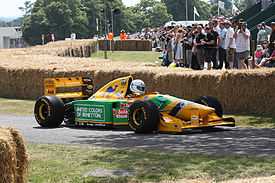Benetton B193
 | |||||||||
| Category | Formula One | ||||||||
|---|---|---|---|---|---|---|---|---|---|
| Constructor | Benetton Formula Ltd. | ||||||||
| Designer(s) |
Ross Brawn Rory Byrne | ||||||||
| Predecessor | B192 | ||||||||
| Successor | B194 | ||||||||
| Technical specifications[1][2] | |||||||||
| Chassis | Carbon fibre monocoque | ||||||||
| Suspension (front) | Double wishbones, pushrod | ||||||||
| Suspension (rear) | Double wishbones, pushrod | ||||||||
| Axle track |
Front: 1,690 mm (67 in) Rear: 1,618 mm (63.7 in) | ||||||||
| Wheelbase | 2,880 mm (113 in) | ||||||||
| Engine | Ford HBA7 / HBA8, 3,498 cc (213.5 cu in), 75° V8, NA, mid-engine, longitudinally mounted | ||||||||
| Transmission | Benetton transverse 6-speed semi-automatic | ||||||||
| Weight | 505 kg (1,113 lb) | ||||||||
| Fuel | Elf | ||||||||
| Tyres | Goodyear | ||||||||
| Competition history | |||||||||
| Notable entrants | Camel Benetton Ford | ||||||||
| Notable drivers |
5. 6. | ||||||||
| Debut | 1993 South African Grand Prix | ||||||||
| |||||||||
| Constructors' Championships | 0 | ||||||||
| Drivers' Championships | 0 | ||||||||
The Benetton B193 was a Formula One racing car designed by Ross Brawn and Rory Byrne and raced by Benetton team in the 1993 Formula One season. It was powered by the latest Cosworth HBA engine in an exclusive deal with Ford and it ran on Goodyear tyres.
The car is distinguishable from its predecessor due to its track being narrower per the regulations of 1993, and the addition of bargeboards at the San Marino Grand Prix. It is otherwise visually almost identical to the preceding car.
In terms of performance it was an improvement on the 1992 competitor.
Thanks to the more powerful engine, Michael Schumacher was able to consistently challenge the McLarens and on occasion challenged the seemingly unbeatable Williams FW15C.
It is arguable that it was overall the second most competitive car on the grid, behind the Williams, with Schumacher regularly scoring podiums and out-qualifying the single-lap ace Ayrton Senna in 8 of the 16 races of the season. Having a factory engine in contrast to McLaren having to make do with a customer unit gave Benetton a noticeable power advantage, although Williams used a far superior Renault V10 unit, however the McLaren had the edge at some races, in particular in wet conditions.
The car was very advanced in the technological sense and featured active suspension, a semi-automatic transmission and traction control from the Monaco Grand Prix onwards although Riccardo Patrese did later say that the car was a step down in quality compared to the much more sophisticated Williams cars he had been driving for the previous five years.
A variant of this car, the B193C was used as a test mule for an innovative four-wheel steering system and was tested by Schumacher and Patrese at Estoril. Four wheel steering had been introduced on some of Nissan and Toyota's production cars. Schumacher and Patrese both found the system to not add anything to the performance of the car and actually slowed the car through slower corners. The system was then abandoned after Schumacher ran the car in Friday's practice session for the Japanese Grand Prix. The system would only have been legal for those 2 races; advanced technologies to aid drivers were banned for the 1994 season.[3]
It was the last car to feature cigarette brand Camel as the team's main sponsor, before the long term sponsorship of an Enstone-based team with Mild Seven.
Benetton eventually finished 3rd in the Constructors' Championship just behind McLaren but with a substantial gap to Williams. The B193B was replaced for the 1994 season by the Benetton B194.
Complete Formula One results
(key) (results in italics indicate fastest lap)
| Year | Team | Chassis | Engine | Tyres | Driver | 1 | 2 | 3 | 4 | 5 | 6 | 7 | 8 | 9 | 10 | 11 | 12 | 13 | 14 | 15 | 16 | Pts. | WCC |
|---|---|---|---|---|---|---|---|---|---|---|---|---|---|---|---|---|---|---|---|---|---|---|---|
| 1993 | Camel Benetton | Ford HBA7 / HBA8 V8 |
G | RSA | BRA | EUR | SMR | ESP | MON | CAN | FRA | GBR | GER | HUN | BEL | ITA | POR | JPN | AUS | 72 | 3rd | ||
| B193 | Michael Schumacher | Ret | 3 | ||||||||||||||||||||
| B193B | Ret | 2 | 3 | Ret | 2 | 3 | 2 | 2 | Ret | 2 | Ret | 1 | Ret | Ret | |||||||||
| B193 | Riccardo Patrese | Ret | Ret | ||||||||||||||||||||
| B193B | 5 | Ret | 4 | Ret | Ret | 10 | 3 | 5 | 2 | 6 | 5 | 16 | Ret | 8 |
References
- ↑ "STATS F1 • Benetton B193". Statsf1.com. Retrieved 2010-08-23.
- ↑ "STATS F1 • Benetton B193B". Statsf1.com. Retrieved 2010-08-23.
- ↑ http://www.f1fanatic.co.uk/2007/03/22/banned-four-wheel-steering
External links
| Wikimedia Commons has media related to Benetton B193. |
| ||||||
| ||||||